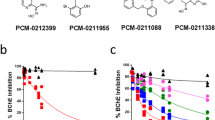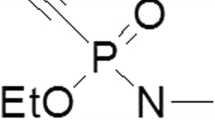Abstract
Methamidophos causes acute cholinergic toxicity in several species, including man, and organophosphate-induced delayed polyneuropathy which has been reported in man but not in the hen. Acetylcholinesterase (AChE) and neuropathy target esterase (NTE) are thought to be the molecular targets of acute and delayed toxicity, respectively. The rate constants of inhibition (ka) and reactivation (k+3) of human and hen brain AChE and NTE by methamidophos resolved optical isomers are here reported. NTE inhibition was progressive and irreversible. Human and hen NTE ka (M−1·m−1) ford-(+) methamidophos was 88 and 59, respectively, and forl-(−) methamidophos 3.2 and 3.0, respectively. AChE spontaneously reactivates after inhibition.d-(+) methamidophos 10−3·ka (M−1·m−1) for human and hen AChE was 0.24 and 0.13; 103·k+3 (m−1) was 0.83 and 0.69, respectively,l-(−) Methamidophos 10−3·ka (M−1·m−1) for human and hen AChE was 5.7 and 2.8, whereas 103 · k+3 (m−1) was 6.50 and 1.52, respectively.l-(−)-Inhibited AChE reactivated to about 60% for human and 30% for hen enzymes, respectively.d-(+)-Inhibited AChE reactivated to about 10–20% for both species. Maximal reactivation occurred within 4–6 h when a plateau was reached. The larger and faster reactivation of human AChE inhibited in vitro byl-(−) methamidophos suggests that a corresponding effect might be possible in vivo and therefore explain, in part, the relatively higher susceptibility of man to delayed polyneuropathy induced by racemic methamidophos which occurs, however, with doses always causing severe cholinergic toxicity.
Similar content being viewed by others
References
Aldridge WN, Reiner E (1972) Enzyme inhibitors as substrates. North-Holland Publ. Co., Amsterdam-London
AriËns EJ, van Rensen JJS, Welling W (eds) (1988) Stereoselectivity of pesticides. Biological and chemical problems. Elsevier Science Publ. Co. Inc., New York
Caroldi S, Lotti M (1982) Neurotoxic esterase in peripheral nerve: assays, inhibition and rate of resynthesis. Toxicol Appl Pharmacol 62: 498–501
de Jong LPA, Benschop HP (1988) Biochemical and toxicological implications of chirality in anticholinesterase organophosphates. In: AriËns EJ, van Rensen JJS, Welling W (eds), Stereoselectivity of pesticides. Biological and chemical problems, Elsevier Science Publ. Co. Inc., New York, pp 109–149
de Jong LPA, Wolring GZ, Benschop HP (1982) Reactivation of Acetylcholinesterase inhibited by methamidophos and analogous (Di)methylphosphoroamidates. Arch Toxicol 49: 175–183
Edmundson RS (ed) (1988) Dictionary of organophosphorus compounds. Chapman and Hall, London and New York, p 519
Ellman GL, Courtney KK, Andres WJr, Featherstone RM (1961) A new and rapid colorimetric determination of acetylcholinesterase activity. Biochem Pharmacol 7: 88–95
FAO/WHO (1983) Pesticides residues in food. 1982 Evaluations of the Joint Meeting of the FAO panel of experts on pesticide residues in food and environment and the WHO expert group on pesticide residues. FAO/Rome, p 313
Johnson MK (1977) Improved assay of neurotoxic esterase for screening organophosphates for delayed neurotoxicity potential. Arch Toxicol 37: 113–115
Johnson MK (1982) The target for initiation of delayed neurotoxicity of organophosphorus esters: biochemical studies and toxicological applications. Rev Biochem Toxicol 4: 141–212
Johnson MK (1987) Receptor or enzyme: the puzzle of NTE and organophosphate-induced delayed polyneuropathy. TIPS 8: 174–179
Johnson MK, Read DJ (1987) The influence of chirality on the delayed neuropathic potential of some organophosphorus esters: neuropathic and protective effects of stereoisomeric esters of ethyl phenylphosphonic acid (EPN oxon and EPN) correlate with quantities of aged and unaged neuropathy target esterase in vivo. Toxicol Appl Pharmacol 90: 103–115
Johnson MK, Read DJ, Benschop HP (1985) Interaction of the four stereoisomers of soman pinacolyl methylphosphonofluoridate with acetylcholinesterase and neuropathy target esterase of hen brain. Biochem Pharmacol 34: 1945–1951
Johnson MK, Read DJ, Yoshikawa H (1986) The effect of steric factors on the interaction of some phenylphosphonates with acetylcholinesterase and neuropathy target esterase of hen brain. Pest Biochem Physiol 25: 133–142
Khasawinah AMA, March RB, Fukuto TR (1978) Insecticidal properties, antiesterase activities and metabolism of methamidophos. Pest Biochem Physiol 9: 211–221
Lotti M (1987) Organophosphate-induced delayed polyneuropathy in man and perspectives for biomonitoring. TIPS 8: 176–177
Lotti M, Johnson MK (1978) Neurotoxicity of organophosphorus pesticides: predictions can be based on in vitro studies with hen and human enzymes. Arch Toxicol 41: 215–221
Lotti M, Johnson MK (1980) Neurotoxic esterase in human nervous tissue. J Neurochem 34: 747–749
Lotti M, Moretto A, Traverso R (1989) Serum “A”-esterases and organophosphates toxicity in man. In: Reiner E, Aldridge WN, Hoskin FCG (eds) Esterase hydrolysing organophosphorus compounds. Ellis Horwood, Chichester, pp 193–201
Moretto A, Lotti M, Spencer PS (1989) In vivo and in vitro regional differential sensitivity of neuropathy target esterase to di-n-butyl-2,2-dichlorovinyl phosphate. Arch Toxicol 63: 469–473
Senanayake N, Johnson MK (1982) Acute polyneuropathy after poisoning by a new organophosphate insecticide. New Engl J Med 306: 155–157
Thompson CM, Fukuto TR (1982) Mechanism of cholinesterase inhibition by methamidophos. J Agric Food Chem 30: 282–284
Vilanova E, Johnson MK, Vicedo JL (1987) Interaction of some unsubstituted phosphoroamidate analogs of methamidophos (O,S-dimethylphosphoroamidothioate) with acetylcholinesterase and neuropathy target esterase of hen brain. Pest Biochem Physiol 28: 224–238
Wing KD, Glickman AH, Casida JE (1982) Oxidative bioactivation of S-alkyl phosphorothiolate pesticides: stereospecificity of profenofos insecticide activation. Science: 219: 63–65
Author information
Authors and Affiliations
Rights and permissions
About this article
Cite this article
Bertolazzi, M., Caroldi, S., Moretto, A. et al. Interaction of methamidophos with hen and human acetylcholinesterase and neuropathy target esterase. Arch Toxicol 65, 580–585 (1991). https://doi.org/10.1007/BF01973720
Received:
Accepted:
Issue Date:
DOI: https://doi.org/10.1007/BF01973720




